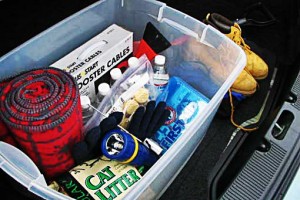Imagine you’re stranded on the road. Maybe you’re lost on a back road, have a flat tire or are stuck in a bad storm. Is your vehicle equipped with supplies to help you stay safe until help arrives? Use this checklist to prepare an emergency kit in all your vehicles today.

Flat Tire Repair
Almost anyone can replace or repair a flat tire as long as the vehicle isn’t on a busy highway. Besides a spare tire that’s properly inflated, stock a jack, a torque wrench and a patch kit. Additionally, a tarp protects your knees as you change the tire, and flares alert other drivers that your vehicle is disabled.
Minor Vehicle Repair
Sometimes, minor repairs are all your vehicle needs to get it back on the road. Always stock a quart or two of oil, a gallon of antifreeze, fuses, screwdrivers and duct tape. You’ll also want jumper cables, a fire extinguisher, a rag to check fluids and a flashlight.
Overnight Bag
Hopefully, help will arrive quickly, but you must be prepared in case you need to spend the night in your vehicle or a local hotel. A change of clothes, socks and shoes are essential supplies if you’re stranded overnight. You can also wear your extra clothes to stay warm if it’s cold. And toiletries like a toothbrush, toothpaste, comb, deodorant, wet wipes and hand sanitizer help you stay clean and comfortable no matter how long you’re stranded.
No emergency kit is complete until you add food and water. At the very least, pack granola or energy bars and bottled water so you stay hydrated and energized.
If you frequently travel with kids, pack a change of clothes, extra diapers and wipes as well as a few toys and snacks. These supplies make being stranded easier on your children and a bit less stressful for you.
First Aid
You never know what you might encounter on the road, and your first aid kit could save your life. A small kit with essentials will work if you don’t have extra space for a large kit. At the very least, include pain reliever, alcohol wipes, antiseptic ointment, burn cream, gauze and bandages. Include cough and cold medicine, tweezers and hot/cold packs if you have room. Check the supplies every six months to replace expired medicine and restock the kit.
Communication Devices
Help is only a call away, but you can’t call for help if your cellphone isn’t charged or accessible. Before every trip, charge your phone and secure it to the visor. If you’re in an area where your phone doesn’t have reception, carry a whistle, blank paper and a pen. Use the whistle to signal for help, and write a “help needed” sign if you have to leave the car or are on a busy road.
Remember to label and store your emergency contact’s name and phone number under ICE, In Case of Emergency, or at the top of the list. That way, emergency personnel can locate your family if you’re in an accident.
You don’t want to be caught stranded along the road, but accidents happen. Be prepared when you follow this emergency kit checklist. Then make time today to stock one and store it in your vehicle before you drive anywhere.

